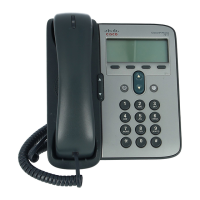
Do you have a question about the Cisco 7911G - IP Phone VoIP and is the answer not in the manual?
Provides a summary of the document's scope, purpose, and content.
Defines the intended readers and their required technical background for the manual.
Describes the structure and flow of information presented in the manual.
Lists other Cisco publications for additional information and context.
Provides guidance on accessing Cisco resources, support, and security policies.
Outlines the product's compliance with cryptographic regulations and export laws.
Explains the formatting, symbols, and typographical conventions used throughout the document.
Details the features, design, and capabilities of the Cisco Unified IP Phone models.
Explains the essential networking protocols that enable voice communication over IP networks.
Lists and describes the core telephony and productivity features supported by the IP phones.
Covers the security mechanisms implemented to protect the phone and network communications.
Provides a high-level overview of the procedures for setting up and deploying the IP phones.
Explains how the IP phones interact with other Cisco Unified Communications components.
Details the methods for powering the Cisco Unified IP Phones, including PoE and external adapters.
Explains the role and content of configuration files stored on the TFTP server.
Describes the sequence of steps the phone follows during its startup process.
Outlines various methods for registering IP phones with the Cisco Unified Communications Manager.
Discusses support for SCCP and SIP protocols and how to convert between them.
Provides methods to identify the unique MAC address of the Cisco Unified IP Phone.
Outlines the prerequisites and initial considerations before starting the phone setup process.
Describes the physical parts, ports, and accessories of the Cisco Unified IP Phone models.
Provides detailed step-by-step instructions for the physical installation of the IP phone.
Details the procedure for securely mounting the Cisco Unified IP Phone onto a wall.
Explains how to confirm that the phone is starting up correctly and displaying information.
Covers manual configuration of IP address, DNS, and TFTP settings if DHCP is not used.
Details the steps for setting up security features, including certificates and authentication.
Introduces the on-device menus for accessing and changing phone configuration options.
Lists the general settings that can be adjusted directly from the phone's interface.
Details network settings such as IP address, DHCP, TFTP, and VLAN configuration.
Covers phone-specific settings including CallManager, SIP, and media configurations.
Explains security options like device authentication, CTL files, and 802.1X settings.
Lists and describes various call handling features and their configuration.
Explains how to set up and use corporate and personal contact directories.
Details how to customize the layout and assignment of features to phone buttons.
Covers the management and customization of softkey appearances and functions.
Guides on configuring and enabling various phone services like XML applications.
Describes the process of creating and managing user accounts within the UCM system.
Explains how users can customize their phone features and settings through a web interface.
Guides on editing XML configuration files and uploading custom resources to the TFTP server.
Details the process of creating and implementing custom ringtones for the IP phones.
Explains how to add custom PNG images and list them for phone background selection.
Covers the configuration and use of wideband audio codecs for improved voice quality.
Displays detailed hardware and software information about the IP phone.
Provides access to screens showing system messages, network stats, and firmware versions.
Shows the most recent system messages, including potential error indicators and actions.
Displays detailed Ethernet traffic statistics for network performance analysis.
Lists the firmware versions currently running on the phone.
Provides call counters and voice quality metrics for recent call activity.
Details the procedure for connecting to the IP phone's web management interface.
Covers security settings to control remote access to the phone's web interface.
Displays detailed hardware and software information via the phone's web page.
Shows network settings and status information accessible through the phone's web page.
Provides detailed network traffic statistics viewable through the phone's web page.
Allows access to various log files for troubleshooting purposes via the web interface.
Displays real-time stream data and quality metrics accessible through the phone's web page.
Guides on troubleshooting issues that prevent the Cisco Unified IP Phone from starting up.
Addresses common causes and solutions for unexpected phone resets during calls or idle states.
Covers security-related issues and provides troubleshooting steps for authentication and configuration.
Offers solutions for common operational issues like daisy-chaining, voice quality, and display problems.
Explains procedures for performing basic and factory resets to restore phone settings.
Details how to use the Quality Report Tool (QRT) for reporting call quality issues.
Explains how to interpret voice quality metrics like MOS LQK and Conceal Ratio.
Provides links to Cisco.com resources for advanced troubleshooting assistance.
Offers basic instructions on how to clean the phone's exterior and screen.
Guides on how to provide end-users with contact information for phone support and assistance.
Information for administrators on how end-users can access phone documentation.
Explains how end-users can access web pages to manage services and phone settings.
Provides end-users with instructions on accessing their voice mail accounts.
Details how end-users can manage their personal contact entries and synchronize address books.
Provides a high-level comparison of calling features supported by SCCP and SIP protocols.
Lists the operating temperature, humidity, and physical dimensions of the IP phones.
Details the types of cables and connectors used for phone connectivity.
Provides pinout diagrams for the network and access ports on the IP phones.

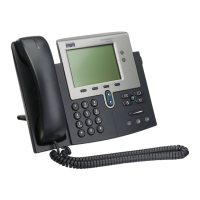

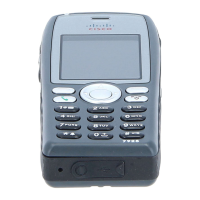
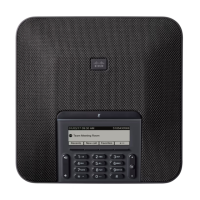
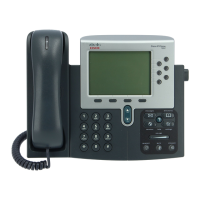
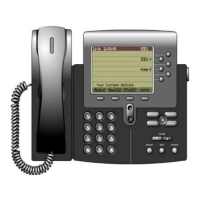
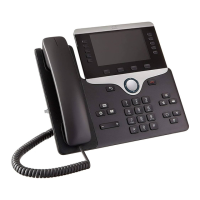
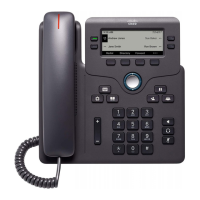
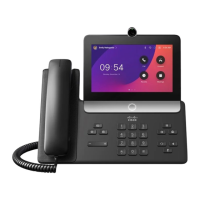

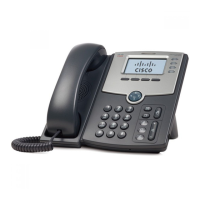
